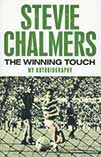 My autobiography
My autobiography
by Stevie Chalmers with Graham McColl
Headline, £19.99
Reviewed by Mark Poole
From WSC 314 April 2013
Stevie Chalmers scored the winning goal in the 1967 European Cup final. It’s still the most important goal in Celtic’s history: the goal that liberated club football’s greatest prize from its Spanish-Italian-Portuguese stranglehold for the first time and that inspired Bill Shankly to call Jock Stein immortal.
Chalmers scored 230 other goals for Celtic – including the last hat-trick in an Old Firm derby – but his career has come to be defined solely by his tap-in (team-mate Bertie Auld’s words) against Inter in Lisbon. His autobiography does nothing to change that. The middle two chapters, one for each half of that final, are where the book comes alive and Chalmers’s detailed perspective of the match is compelling reading for Celtic fans.
There are other intriguing aspects to his life and career: he almost died from tuberculous meningitis when he was 20, he only played five times for Scotland (in spite of his clear talent and scoring against Brazil) and he had a long career at the club he supported but an uneasy relationship with its most successful manager.
His perspective on Stein is interesting but no more so than many others and, perhaps unsurprisingly for a renowned gentleman, Chalmers seems reluctant to complain directly about being overlooked or played out of position.
A lot remains unsaid, leaving readers to infer much of the story. Like many of his contemporaries, Chalmers repeatedly insists that he would always rather do what was best for the team than for himself. However, it’s clear that some managers’ and selectors’ tactics and decisions (including Stein’s) still rankle with him over 40 years later, particularly his omission from the Scotland team that beat England at Wembley in 1967.
It’s a melancholy experience to intrude upon such a successful player’s feelings of loss. Stein was a notoriously hard man to read – his players’ feelings were rarely allowed to intrude on the business of winning matches – but his choices as a manager made it clear how much he valued Chalmers. The reader is left to wonder if Chalmers realises this and also if he would seem more content now if he’d made more of a fuss back then. This glimpse into a 1960s footballer’s mind is one of the more interesting aspects of the book.
The Winning Touch could have provided more of an insight into what it was like to experience Chalmers’s terrible illness, and to recover so remarkably from it. This presence of detail but absence of insight is symptomatic of other parts of the book, perhaps evidence of the adage that consummate professionals often produce mostly pedestrian autobiographies and typical of the emotional restraint of mid-century Scotsmen.
In his playing days Chalmers made the most of the chances that came his way, so it’s surprising that parts of his autobiography seem like a missed opportunity. Although it is worth reading, at least for the insight into the day when he and ten other men from the edge of the football world shocked the game’s aristocracy.